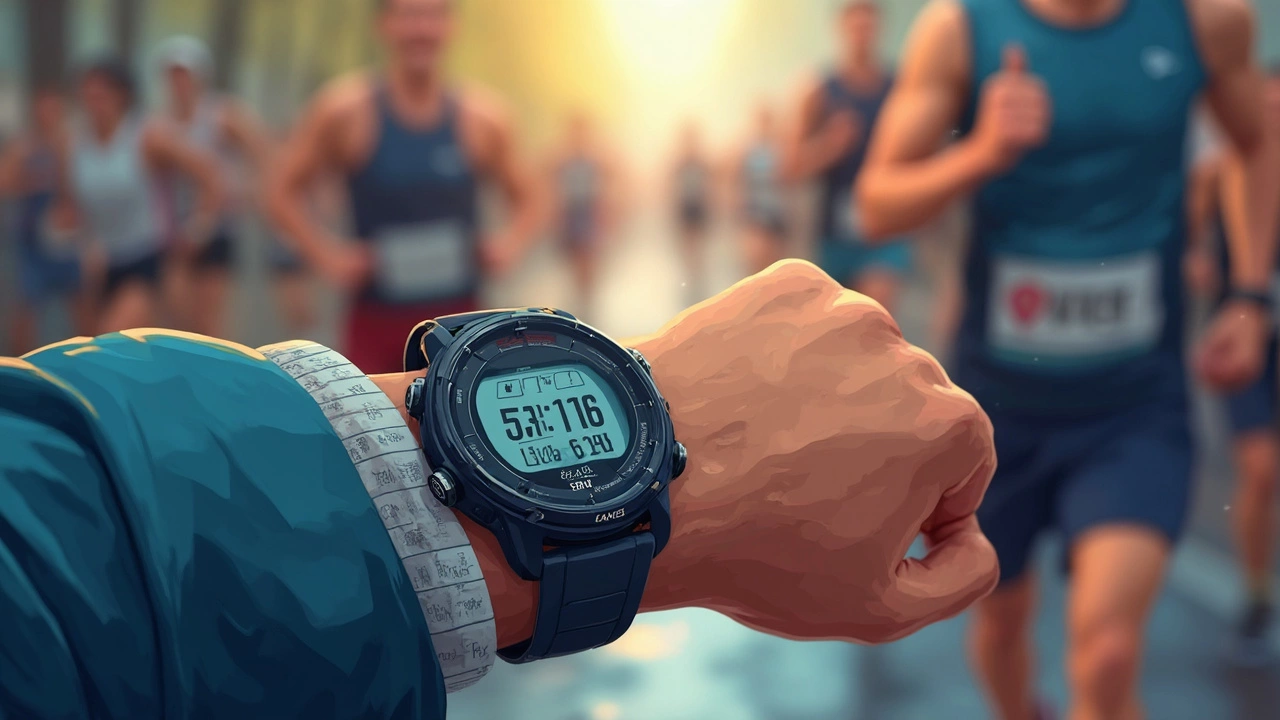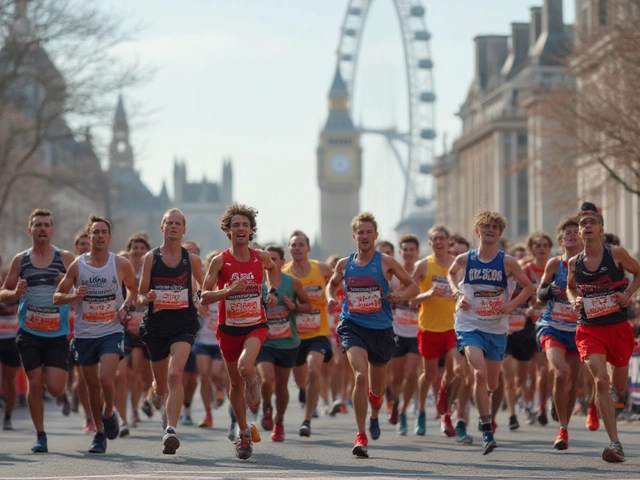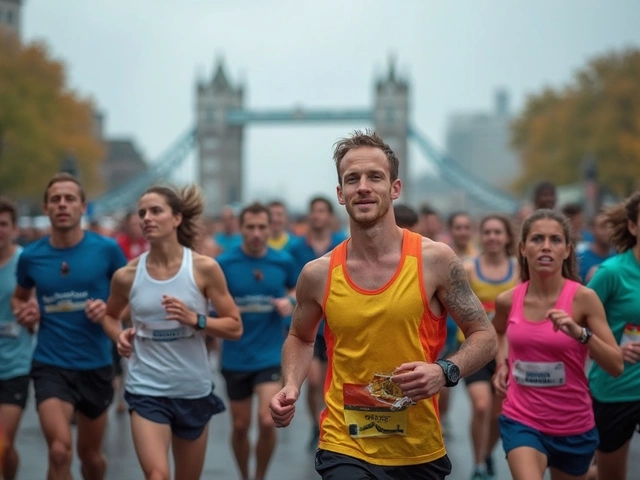Ever wondered if you could run a marathon in five hours? Here’s how the math shakes out: you have to keep your pace right at 11 minutes and 27 seconds per mile. If you think in kilometers, it’s around 7 minutes and 6 seconds per kilometer. That’s your new magic number if you’re eyeing that 5-hour finish line.
This pace is steady—not blazing fast, but you’ll be working. It’s fast enough that you can’t slack off, slow enough to chat a bit or take in the sights. A lot of runners fall into this window, especially in the back half of big races, so you’re definitely not alone if you’re chasing this goal.
Aiming for five hours isn’t just about speed. It’s about sticking to a plan, looking out for the wall at mile 20, and not letting little mistakes mess with your rhythm. Knowing the exact pace you need per mile (or per kilometer) helps you choose a training plan and avoid burning out early. You’ll want to practice this pace a lot—imagine it burned into your brain, so it feels normal, not frantic.
- Breaking Down the 5 Hour Marathon Pace
- What 5 Hour Pace Feels Like in Real Life
- Training Smart for a 5 Hour Finish
- Practical Race Day Tips
- Staying Motivated and Hitting Your Goal
Breaking Down the 5 Hour Marathon Pace
Let’s get straight to the numbers. To complete a marathon (26.2 miles or 42.195 kilometers) in exactly five hours, you need to keep a consistent pace. This pace matters more than you might think—if you start too fast, you'll pay for it later; too slow, and you just won’t make it in time.
| Distance | Total Time | Pace Needed |
|---|---|---|
| 1 mile | 5 hours | 11:27 per mile |
| 1 kilometer | 5 hours | 7:06 per km |
| 5 kilometers | ~35:30 | 7:06 per km |
| 10 kilometers | ~1:11:00 | 7:06 per km |
| Half marathon (13.1 mi) | 2:30:00 | 11:27 per mile |
Most GPS watches and running apps will let you set an alert to help stay on this pace. If you’re old school, a pace band (basically a rubber bracelet listing target split times for each mile) is a lifesaver.
- If you slip above 11:27 per mile even for a few miles, you’ll have to make up for it later—and you really don’t want to do that in the last six miles.
- Consistency beats speed surges. Keeping each split close to your goal makes your finish much smoother.
Here’s a quick fact: Surveys from large city marathons show the median men’s finish is about 4:20, and for women, it’s about 4:45. So a five-hour result means you’re very much in the mix—not at the back, not near the front, but right in the heart of the running community.
Knowing the 5 hour marathon pace takes the guesswork out of your long runs and helps you avoid the classic ‘positive split’ trap, where the first half is way faster than the second. That’s good for your legs—and your confidence—when you hit those brutal late miles.
What 5 Hour Pace Feels Like in Real Life
So, what’s it actually like to run a marathon at this pace? Keeping a steady 11:27 per mile (or 7:06 per kilometer) means you’re jogging steadily, not sprinting, but also not just strolling. For most people, it’s about two minutes slower than what you’d do in a local 5K race. If you chat with runners at your local club, this is the speed where easy conversation is possible at first, but after a couple of hours, you’ll start to feel the miles stack up.
The 5 hour marathon pace is right on that edge where your body is comfortable… until the marathon distance reminds you it’s a long way. The first half usually feels manageable, maybe even easy. Pass mile 16 and suddenly the small aches start. Some folks notice their breath gets heavier or their legs feel stiff. This is totally normal—even for experienced runners at this pace.
Most people aiming for five hours end up taking short walk breaks—sometimes at water stops, sometimes just to shake out the legs. A lot of official pace groups for this goal use a run-walk approach. You won’t be at the front of the race, but you’ll never be last either. The crowd around you is full of real people: folks running for charity, those taking on their first 26.2, and runners just determined to finish smiling.
If you train at this pace, long runs will feel steady but doable. On tired days, your heart rate will creep up faster, and if it’s a hot race day, you’ll find you need more fluids than you expected. You’ll probably pass—and get passed by—the same handful of people a dozen times as everyone fights their own battle to the finish. The pace is achievable, but it demands respect. Stick to it too rigidly early on, and the last six miles may still get tough. Get the hang of it in training, and race day is way less stressful.

Training Smart for a 5 Hour Finish
Aiming for a 5 hour marathon pace is all about training at the right level, not just running random miles. Start with a realistic plan—most plans stretch out 16 to 20 weeks. That gives your legs time to handle longer runs without feeling beat up. You want to hit that 11:27 per mile pace during some long runs, not just short ones. Practicing race pace is key so you know what it really feels like when you’re tired and the race isn’t even halfway done.
Here’s what most solid training schedules include:
- Long Runs: Once a week, add a mile or two each time, peaking with at least one 18- to 20-miler. Practice fueling and pacing during these runs, treat them like mini dress rehearsals for race day.
- Tempo Runs: One day a week, run a bit faster than goal pace for a few miles—this helps make the marathon pace feel manageable.
- Easy Recovery Runs: Don’t skip these. Keeping some runs truly easy helps your body bounce back.
- Rest Days: Bake in at least one full day off running weekly. Even pros don’t run every single day.
- Strength Work: You don’t need a gym membership. Simple bodyweight stuff—lunges, squats, and planks—helps keep injuries away.
Pay attention to fueling and hydration too. During long runs, take in water and carbs every 30-45 minutes—think gels or chews. Don’t try something totally new on race day unless you’re ready to risk gut issues. Shoes matter too: rotate a couple pairs if possible, and make sure your marathon-day shoes have at least 50-100 “break-in” miles on them.
If you miss a run here or there, don’t freak out. Consistency over the weeks is way more important than pulling off a single “perfect” week. Track your pace, listen to your body, and focus on getting to that starting line healthy. That’s the best way to actually see that finish line at the five-hour mark.
Practical Race Day Tips
Race day nerves? Totally normal. A lot can go sideways in 42.2 kilometers if you’re not ready. These tips help you keep your cool, stay on track, and actually enjoy crossing the finish line.
5 hour marathon pace is your target—the key is to stick to it right from the start. Don’t get sucked into the hype and blast out of the gate faster than you’ve trained for. According to race pacing data, about 60% of amateur marathoners finish at a slower pace than they started, mostly because they set off too quickly. Don’t be that runner.
| Checkpoint | Time | Pace/mile | Pace/km |
|---|---|---|---|
| 10K | 1:11:00 | 11:27 | 7:06 |
| Half (13.1 miles) | 2:30:00 | 11:27 | 7:06 |
| 30K | 3:33:00 | 11:27 | 7:06 |
| Finish (42.2K/26.2 miles) | 5:00:00 | 11:27 | 7:06 |
Stick with your fueling plan. Most marathoners burn through 2,500–3,500 calories during the race, but your body can only absorb around 200–300 calories per hour while running. That’s why gels, chews, or sports drinks every 30–40 minutes are non-negotiable.
Don’t skip water stations, even in cool weather. Sweat rates and dehydration can sneak up on you, especially over so many hours. Weigh yourself before and after a training run to check your fluid loss—losing 2% or more of your body weight from dehydration can wreck your day.
Plan your clothing for race morning like a pro. Lay everything out the night before, from your shoes down to your socks and pace band. Last-minute gear swaps cause hassle and chafing. And trust what professional coach Jeff Galloway once said:
"Nothing new on race day. Don’t eat, wear, or try anything for the first time when it counts."
Try these race day tips to keep you cruising:
- Arrive early to avoid panic—start lines get crowded fast.
- Use a GPS watch set with your pace, or run with a pace group if available.
- Set reminders (lap beeps or splits) to keep you honest in those first few miles.
- Smile and thank volunteers—it helps distract from tough moments!
- Have an emergency backup (salt tab, pain reliever, extra gel) in your pocket.
The mental game is real. You’re out there for hours, so break the race into chunks. One coach swears by this trick: “Treat the first 20 miles like a long warm-up. The race only really starts at mile 20.” Remind yourself of this when your legs feel heavy—everyone deals with it. Stay steady, fuel smart, and you’re golden.

Staying Motivated and Hitting Your Goal
Getting fired up for 26.2 miles is great—staying fired up is the hard part. Especially when you’re targeting a 5 hour marathon pace, there will be stretches in training and on race day when it’s way too easy to start doubting yourself. The secret? Set up little systems that keep you on course, not just physically but also mentally.
First, tracking progress does wonders. Cross off completed runs on a calendar, or watch those long-run numbers add up in your tracker app. A 2023 study by Strava found runners who logged their workouts publicly were 43% more likely to stick with their goal for the year—peer pressure works, even if it’s just virtual.
Don’t try to muscle through the mental game alone. Join a local group or find an online community—Facebook, Reddit, and Strava all have solid groups for marathon training. When you’re being cheered on by folks who actually know how hard this is, quitting suddenly feels a lot less tempting.
If you hit a slump, try these tricks to reset your brain:
- Break your training into bite-sized goals—like "hit every long run this month" instead of just "run a marathon."
- Line up a playlist or podcasts specifically for long runs, so you have something to look forward to mid-mile slog.
- Write out your "why" on a sticky note and slap it somewhere you see before every run.
- Change up your routes to avoid boredom.
Come race day, have something in your back pocket mentally—mantras, songs, or even the promise of a good meal at the finish. Lots of runners swear by visualizing the end well in advance. Picture yourself crossing that finish line. It’s cheesy, but the science backs it: Mental imagery can boost performance by up to 13%, according to the Journal of Sports Sciences (2022).
Here’s a quick rundown of common motivation-boosters and how effective runners find them:
| Motivation Trick | What % of Marathoners Use It | Reported Success |
|---|---|---|
| Running Apps for Progress Tracking | 68% | High |
| Training Partner or Group | 54% | Medium-High |
| Personal Mantras | 36% | Medium |
| Music/Podcasts | 72% | High |
| Changing Routes Often | 29% | Medium |
Last thing—don’t attach everything to the clock. Even if you miss your goal, sticking through months of training is a massive win. The habits, the community, the weird pride you get from calling yourself a marathoner? Those last long after you take off your race bib.








